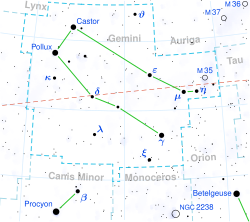Top Qs
Timeline
Chat
Perspective
74 Geminorum
Giant star in the constellation Gemini From Wikipedia, the free encyclopedia
Remove ads
74 Geminorum (f Geminorum) is a K-type giant star in the constellation Gemini. It is located about 640 light-years from Earth based on its Gaia DR3 parallax. The star is often subject to lunar occultations, allowing an accurate measurement of its angular diameter.[6] It has an apparent magnitude of 5.05, making it faintly visible to the naked eye.[1]
Remove ads
Characteristics
Summarize
Perspective
Based on its spectral type of K5.5III, it is a star that has left the main sequence and evolved into a K-type giant star.[3] It radiates about 670 times the solar luminosity from its photosphere at an effective temperature of 3,933 K.[7] The angular diameter, as measured by a lunar occultation, is 3.12±0.06 milliarcseconds.[6] At the current distance of 163.1 pc (532 light-years), as measured by a Hipparcos parallax of 6.13 milliarcseconds,[4] it gives a physical size of 89.6 R☉.
74 Geminorum has an apparent magnitude of 5.05,[3] making it visible to the naked eye only from locations with dark skies, far from light pollution.[1] The absolute magnitude, i.e. the magnitude of the star if it was seen at 10 parsecs (33 ly), is -1.01.[1] It is located in the coordinates RA 07h 39m 28.59s, DEC +17° 40′ 28.3″, which is within the Gemini constellation.[3][8] The star is moving away from Earth at a velocity of 25.38 km/s.[5] f Geminorum is the star's Bayer designation. Other designations for the star include 74 Geminorum (the Flamsteed designation), HIP 37300 (from the Hipparcos catalogue), HR 2938 (from the Bright Star Catalogue) and HD 61338 (from the Henry Draper Catalogue).[3]
The star is often subject to lunar occultations. One of these occultations were observed by the SAO RAS 6-m telescope, which allowed the angular diameter of 74 Geminorum to be accurately measured at 3.12±0.06 milliarcseconds.[6]
Remove ads
See also
Notes
- From an angular diameter of 6.13 milliarcseconds[6] and a distance of 163.1 parsecs.[4]
References
Wikiwand - on
Seamless Wikipedia browsing. On steroids.
Remove ads

